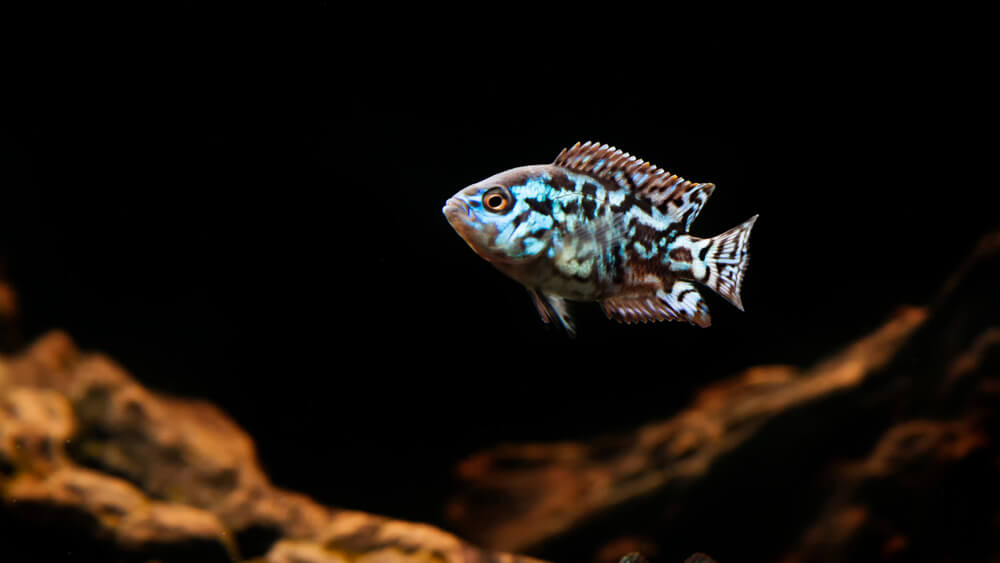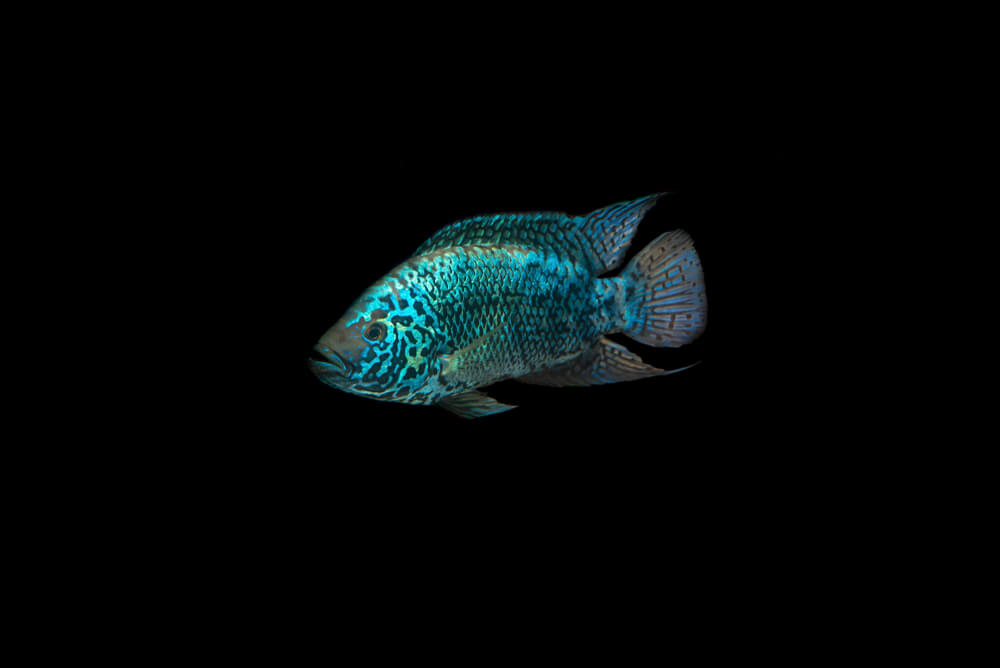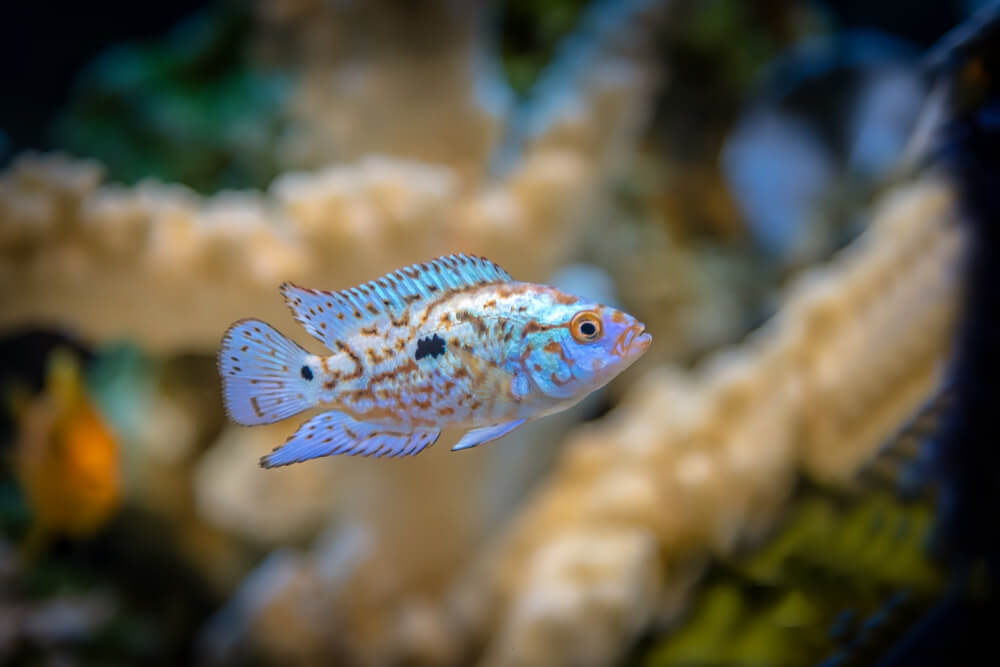Electric Blue Jack Dempsey: Care, Diet, Size, and More
Posted by Miles Harrison on 09/30/2022
We use affiliate links and may receive a small commission on purchases.
If you've ever seen an Electric Blue Jack Dempsey in person, you are probably not surprised to know that they are one of the brightest freshwater aquarium species available in the hobby.
If you’re looking for a small, peaceful fish, then you may want to stay clear of the Electric Blue Jack Dempsey.
But if you don't mind a semi-aggressive species, the Electric Blue Jack Dempsey might be your new favorite fish!
In this post, we’ll discuss care, common diseases, tank mates, and we’ll even dive into the history behind the name of this fish. After reading this guide, you’ll have all of the information needed to decide whether or not this unique fish should be the next addition to your freshwater aquarium.
Species Summary
Named after boxer Jack Dempsey, the Electric Blue Jack Dempsey shares many similarities to the legendary fighter. This fish will display aggressive behavior, and some say the face of this fish even resembles Jack Dempsey himself.
This variant is much rarer than the traditional Jack Dempsey fish, and its origins are quite controversial. Some claim this species is naturally occurring and can be found throughout Central America and on the Atlantic Coast of Mexico. While others claim the fish was bred by an Argentinian breeder named Hector Luzardo. To this day, there is still additional DNA testing required to determine whether or not the unique coloration of the Electric Blue Jack Dempsey is due to morphing (genetic mutation), or hybridization (the mating of two different species).
Regardless of which origin story you choose to believe, one thing everyone can agree on is that this is a very unique and colorful fish. The Electric Blue Jack Dempsey is a fish that undoubtedly deserves its unique name.

Appearance
The Electric Blue Jack Dempsey has a stunning appearance. While many consider saltwater fish to be some of the most colorful, the Electric Blue Jack Dempsey stands out as an exception.
This thin-bodied fish is bright-blue in color and shimmers when under direct lighting. Its body has specks of black dots, which vary in design and length. The pattern is present on the head, body, lips, and all of the fins, with the only exception being the pectoral fin, which is translucent.
The Electric Blue variation also is known to have longer fins compared to regular Jack Dempsey cichlids. Hobbyists might also notice that the shapes of these fish’s skulls vary from fish to fish, a common characteristic of hybridization.
Juvenile Electric Blue Jack Dempseys are a bit paler in color and have white bodies. The white eventually turns into the adult blue color usually once the fish is around 6-7 months old.
As the fish ages, the blue color of the fish will once again turn dull, signaling that the fish is getting closer to the end of its life. This dull coloration will also appear if the fish is stressed, or fed a low-quality diet.
Size
Although Juveniles appear quite small, the Electric Blue Jack Dempsey will grow to be quite a large fish. Adult Electric Blue Jack Dempsey Fish will reach around 8 inches in length
Since this fish is quite large, you’ll want to make sure that you have an aquarium big enough to house this large and aggressive species.
Care Guidelines
If you’re new to fish keeping, the Electric Blue Jack Dempsey makes for an excellent beginner fish when kept alone.
That being said, this fish is known for its aggressive behavior. We only recommend this species for experienced aquarists, if you plan on keeping this fish with additional tankmates.
The Electric Blue Jack Dempsey will benefit from a high-quality diet, bi-weekly 40% water changes, and pristine water conditions.
🛒 Shop Freshwater Fish on Light Fish
Lifespan
As with almost all aquarium fish, lifespan is typically correlated to diet, water quality, and stress. Providing the Electric Blue Jack Dempsey with a large aquarium will ensure that they’re able to live a healthy life.
Hobbyists can expect a healthy Electric Blue Jack Dempsey fish to live for 10-15 years in captivity. Typically, purchased Electric Blue Jack Dempsey fish are adults, usually between 1-2 years in age. You may want to consider inquiring about the age of the fish when purchasing, so you have some estimate of the life expectancy.
Common Diseases
One of the most common diseases that affect freshwater fish is known as Dropsy. Unfortunately, cichlid fish are just as vulnerable to this disease as other types of freshwater fish.
Dropsy is often caused by poor water quality and is commonly seen in fish that experience stress. Stress in fish lowers their immune system, creating the perfect environment for the bacteria that causes dropsy to take hold.
Fish that experience dropsy will typically become quite lethargic. They may lose their appetite and may even hover in place towards the top or bottom of the aquarium.
The most obvious symptom of dropsy is the effect it has on the appearance of the fish. Fish that are affected by dropsy will begin to swell, and almost appear as if they are about to pop, similar to a balloon filling up with helium.
Rest assured, it is possible to cure an Electric Blue Jack Dempsey fish from this disease. If you notice symptoms, immediately move the fish to a mature hospital tank that has pristine water conditions (0 PPM Ammonia & Nitrite.) Then, slowly add Epsom salt to the fish tank. You’ll want to aim for 1 tsp of salt per gallon. After adding the salt, monitor your fish over the next 3 days for signs of improvement.
If your fish shows signs of improvement, continue monitoring water parameters in the hospital tank for an additional week. Once your fish appears back to normal, you can transfer it back into the main tank. However, you must address what might have caused Dropsy in your fish. Perform water tests and do gradual water changes until Ammonia and Nitrite levels are stable. Monitor your fish for stress, and determine whether or not overcrowding might be stressing your Electric Blue Jack Dempsey fish.
Another common disease that can affect this fish is known as white spot disease. White spots will appear on the body of fish affected by this ailment. Treatment of this disease usually involves water changes until there is an improvement in water quality and a brief increase in aquarium temperatures over 3 days. Increasing temperatures to around 85 °F will help eradicate this parasite.
Tank Setup and Water Conditions
Before adding this fish, you’ll want to be sure you have an aquarium that’s large enough. We recommend an aquarium no smaller than 55 gallons for the Electric Blue Jack Dempsey fish. This will ensure that this species has plenty of room to swim, as this fish tends to be quite active in an aquarium.
You’ll want to re-create an environment similar to the native Jack Dempsey fish. In the wild, these fish can be found in tropical waters. They prefer stagnant, or slow-moving currents. Re-creating this setup will be sufficient for an Electric Blue.

Since tropical water tends to be a bit on the warmer side, you’ll want to purchase a heater, such as this one from Fluval to regulate temperature. These fish prefer temperatures between 72-86°F, which you can regulate by using a thermometer.
One of the nicer aspects of keeping an Electric Blue is that you don’t need to purchase additional powerheads to create a fast-moving current. While some fish prefer fast-moving currents, the Electric Blue does not. Providing a large HOB (hang-on-the-back) filter, or a powerful canister filter, such as ones made by Eheim will provide more than enough flow and current for an Electric Blue Jack Dempsey fish.
Now, let’s discuss two important metrics. Potential Hydrogen (pH) and General Hardness (GH). The Electric Blue Jack Dempsey fish prefers pH levels to be between 6-7, and gH levels to be between 9-20dGH. These pH levels put this fish in the slightly acidic range. If your water supply has hard water, you may want to consider purchasing an RO/DI unit . These filters will lower the pH level of the water.
Luckily, these fish will adapt to hard water conditions as long as they are introduced to higher pH waters gradually. Keeping pH levels consistent, by doing bi-weekly 30% water changes will be beneficial when keeping this species.
Lighting
You’ll want to opt for LED lighting when it comes to keeping this eye-catching species. LED lighting is known to provide better coverage when compared to fluorescent lighting, and some LEDs can even be programmed to have seasonal day/night cycles.
Having a quality LED lighting setup will show off the brilliant color of the Electric Blue Jack Dempsey fish!
Substrate
Similar to other types of Cichlid fish, Electric Blues are known for digging and sifting through the substrate. As a result, you’ll want to provide a sand substrate, similar to what we recommend for Discus fish
If you choose to provide a gravel substrate, your fish will most likely push the gravel around, creating unsightly craters. Sand will tend to level itself over time, due to its fine grains.
🛒 Shop Aquarium Plants Fish on Light Fish
Food & Diet
Feeding the Electric Blue Jack Dempsey is relatively straightforward. This fish will accept a wide variety of high-quality dry, frozen, and meaty foods. You’ll want to provide a nice variety of different types of food to ensure your Electric Blue fish has the nutrition needed to live a long and healthy life.
Some feeding options include:
- High-Quality Flake Food
- Thawed Frozen Blood Worms
- Sinking Pellets
- Black Worms
- Daphnia
- Brine Shrimp
You’ll want to feed adult Electric Blue Jack Dempsey fish twice daily, and juveniles can be fed 2-3 times a day.
If your fish is healthy, they should devour the food rather quickly. Feed enough food for them to consume in a 2-3 minute period. If you overfeed, you’ll risk contaminating your water, as decaying food will increase Ammonia levels. Overfeeding can also lead to bloat, so be sure to monitor your fish during the feeding period.
Behavior & Temperament
Electric Blue Jack Dempsey fish are less aggressive than a standard Jack Dempsey fish. However, they still demonstrate aggressive tendencies in captivity. If you plan on keeping this species with other fish, you’ll want to make sure you have a large enough aquarium.
Cichlids tend to be quite territorial, so you’ll want to provide plenty of hardscape for the fish to claim as their own.

Healthy fish will tend to swim near the middle of the water column, and will occasionally swim close to the substrate, sifting through sand to find new food sources.
If you notice your Electric Blue Jack Dempsey becoming lethargic, test your water conditions, and ensure your aquarium is large enough to house this species.
Tankmates
Since the Electric Blue Jack Dempsey fish is semi-aggressive, you’ll need to take caution when adding additional tankmates.
We recommend adding tank mates that are also large and semi-aggressive. Fish that have a peaceful temperament will get bullied by the Electric Blue Jack Dempsey, but larger fish, such as Firemouth Cichlids, will stand their ground, and can happily co-exist with an Electric Blue.
Some potential tankmates we recommend are:
- Convict Cichlids
- Blue Acara
- Clown Loaches
- Rainbow Fish
- Severum Cichlids
- Green Terrors
- Jaguar Cichlids
Avoid adding smaller fish, such as tetras, endlers, or danios. These fish are much too small and peaceful to live with an Electric Blue. The last thing you want is one of these fish to end up as a snack!
Breeding
Electric Blue Jack Dempsey fish are relatively easy to breed. If you are fortunate enough to find a male/female pair that comes from two separate family lines, breeding this fish can be a very rewarding experience.
You’ll know when these fish are ready to breed, as the electric blue color will transition to black. Also referred to as “the black breeding coat”, this coat is a good indicator that you’ll want to transition a male/female pair to a breeding tank.
Your breeding tank should have decorations, such as stones or plants which will be used by a female to lay eggs. Temperatures in this tank should be a few degrees warmer than your main aquarium, and water changes should be performed more frequently. Perform 30% water changes every 3 days to maintain pristine water conditions.
If successful, the female will lay eggs on some of the stones or decorations. The male will then fertilize the eggs. Both fish will aggressively defend the eggs during this period.
After 3 days, watch closely, as the eggs will be ready to hatch! The fish will continue to protect the newly hatched fry for around 10 days. After 10 days, you’ll have successfully bred Electric Blue Jack Dempsey fish!
In Conclusion
Electric Blue Jack Dempsey fish are some of the most brightly colored freshwater fish available in the hobby.
If you’re looking to create a unique freshwater aquarium and can manage the semi-aggressive behavior of this species, this fish might become your new favorite.
Seeing this brightly colored fish swimming in a home aquarium is a sight to see, and provides an incredibly rewarding experience for the freshwater aquarium hobbyist.
We’re confident that you now have all of the information needed to house this exciting species. If you have suggestions for improving this guide, please email us as we would love to hear from you. Happy fish keeping!
December's Giveaways on Light Fish






















